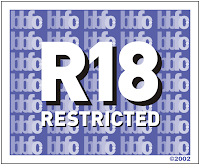The British Board of Film Classification is an independent, non-governmental body, which has classified cinema films since it was set up in 1912, and videos since the passing of the Video Recordings Act in 1984.
18 Restricted
To be shown in specially licensed cinemas, or supplied in licensed sex shops, and to adults no less than 18 years old. The’R18’ category is a special and legally restricted classification primarily for explicit works of consenting sex or strong fetish material involving adults. Films may be shown to adults in specially licensed cinemas, and video works may be supplied to adults only in licensed sex shops ‘R18’ films can not be supplies by mail order.

18
Suitable only for adults. No-one younger than 18 may see an ‘18’ film in the cinema. No-One younger than 18 may rent or buy an ‘18’ rated video work.

15
Suitable only for 15 years or over. No-one younger than 15 may see a ‘15’ film in the cinema. No-One younger than 15 may rent or buy a ‘15’ rated video work.

12/12A
Exactly the same criteria are used to classify works at ‘12A’ and ‘12’. These categories are awarded where the material is suitable, in general, only for those aged 12 or over. Works classified at these categories may upset children under 12 or contain material many parents would find unsuitable for them.
The ‘12A’ category only exists for cinema films. No-one younger than 12 may see a ‘12A’ film in a cinema unless accompanied by an adult and films classified ‘12A’ are not recommended for a child below 12. An adult may take a younger child if, in their judgment, the film is suitable for that particular child. In such circumstances, responsibility for allowing a child under 12 to view lies with the accompanying adult.
The ‘12’ Category exists only for video works. No-one younger than 12 may rent or a buy a ‘12’ rated video work.


PG- Parental Guidance
General viewing, but some scenes may be unsuitable for young children. Unaccompanied children of any age may watch. A ‘PG’ film should not disturb a child aged around eight or older. However, parents are advised to consider whether to content may upset younger or more sensitive children.

U-Universal
It is impossible to predict what might upset a particular child. But a ‘U’ film should be suitable for any child aged over four. ‘U’ films should be set within a positive moral framework and should offer reassuring counterbalances to any violence, threat or horror. If a work is particularly suitable for a pre-school child to view alone, this will be indicated in the Consumer Advice.

Information provided from "http://www.bbfc.co.uk/"














